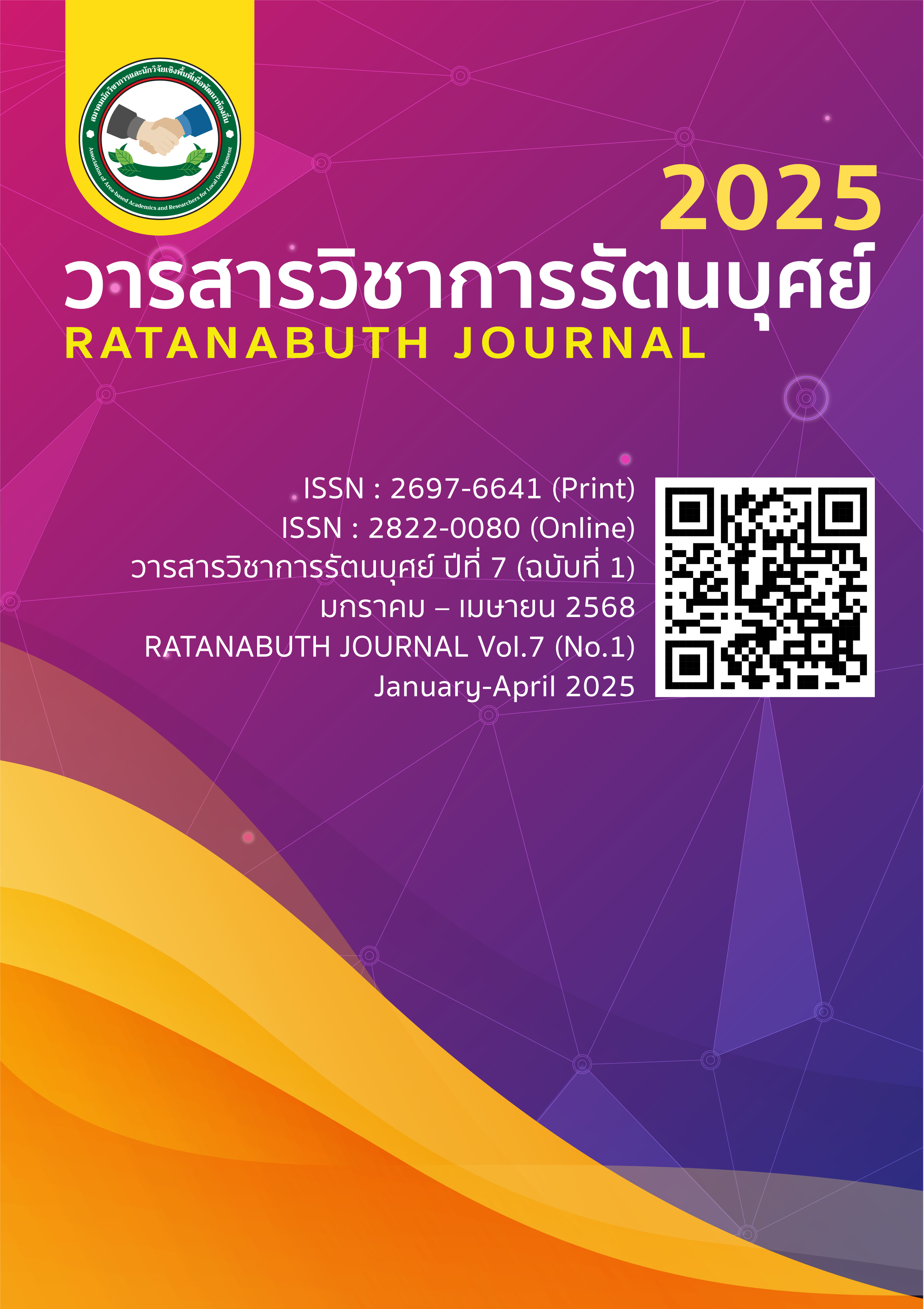Factors affecting recidivism among female inmates in Maha Sarakham Provincial Prison Factors affecting recidivism among female inmates in Maha Sarakham Provincial Prison
Main Article Content
Abstract
Recidivism among female inmates in prison is one of the problems that affects social security and the justice system of the country. It causes inmates to lose the opportunity to re-enter society normally. This research aimed to 1) study the level of factors affecting recidivism among female inmates in Mahasarakham Provincial Prison, 2) to determine the factors affecting recidivism among female inmates in Mahasarakham Provincial Prison, and 3) to study the recommendations for solving the recidivism among female inmates in Mahasarakham Provincial Prison. The sample group consisted of 254 female inmates from Mahasarakham Provincial Prison. The research instrument was a questionnaire. The statistics used were frequency distribution, percentage, mean, standard deviation, and linear multiple regression analysis. The research results found that 1) the level of factors affecting recidivism among female inmates in Mahasarakham Provincial Prison had the highest mean overall. 2) The factors affecting recidivism among female inmates in Mahasarakham Provincial Prison included social and environmental factors, economic factors, political factors, and psychological factors. All 4 factors could predict recidivism among female inmates in Mahasarakham Provincial Prison. 58% correct with statistical significance at .05 level and 3) The results of the analysis of recommendations to solve the recidivism of female prisoners in Maha Sarakham Province can be summarized as follows: 3.1) Promote job opportunities. There should be coordination with private entrepreneurs to provide opportunities for released prisoners to work, reduce obstacles to re-entering society and prevent re-offending. 3.2) Strengthen family relationships. Family activities should be promoted to create warmth and bonding, which is an important factor in reducing the chances of re-offending. 3.3) Create an open attitude in society. Society should be promoted to open up opportunities and accept ex-prisoners so that they can return to work and live a normal life. 3.4) Community leaders’ participation. Community leaders should play a role in reaching out to residents to be aware of the living conditions of each family and be able to provide assistance or solve problems appropriately.
Article Details

This work is licensed under a Creative Commons Attribution-NonCommercial-NoDerivatives 4.0 International License.
References
กรมราชทัณฑ์. (2561). สถิติผู้ต้องราชทัณฑ์ทั่วประเทศ. สืบค้นเมื่อ 4 มิถุนายน 2567 จาก http://www.correct.go.th/stat102/display/result.php?date=2018-03-01&Submit=ตกลง.
กรมราชทัณฑ์. (2563). รายงานสถิติผู้ต้องราชทัณฑ์ทั่วประเทศ. สืบค้นเมื่อ 4 มิถุนายน 2567 จาก http://www.correct.go.th/rt103pdf/report_result.php?date=2020-07.
ฉัตรกุล พงษ์ธรรม. (2556). ปัจจัยที่มีความสัมพันธ์กับพฤติกรรมการกระทำผิดเกี่ยวกับทรัพย์. วิทยานิพนธ์ ปริญญารัฐประศาสนศาสตรมหาบัณฑิต.กรุงเทพมหานคร:สถาบันบัณฑิตพัฒนบริหารศาสตร์.
ชวลิต กลิ่นแข. (2563). ปัจจัยที่ส่งผลต่อการกระทำผิดซ้ำของผู้ต้องขังในเรือนจำของจังหวัดแม่ฮ่องสอน. วารสารวิชาการสถาบันวิทยาการจัดการแห่งแปซิฟิค, 6(3), 253–261.
ทรรศพล ขุนรัง. (2556). สาเหตุการกระทำผิดซ้ำคดีเกี่ยวกับทรัพย์: ศึกษาเฉพาะกรณีความผิดฐานลัก ทรัพย์นักโทษเด็ดขาดฝ่ายควบคุมแดน 8 เรือนจำพิเศษกรุงเทพมหานคร.วิทยานิพนธ์ปริญญารัฐ ประศาสนศาสตรมหาบัณฑิต.กรุงเทพมหานคร: มหาวิทยาลัยเกริก.
บุรฉัตร จันทร์แดง. (2562). ปัจจัยที่มีผลต่อพฤติกรรมเสี่ยงต่อยาเสพติดของนักเรียนชั้นมัธยมศึกษาในเขต พื้นที่ตะเข็บชายแดนลุ่มน้ำโขง. วารสารมหาวิทยาลัยราชภัฏยะลา, 14(3), 424–428.
ภานุวัฒน์ มีเพียร, บุญเหลือ บุบผามาลา. (2565). ปัจจัยที่ทำให้มีการกระทำผิดซ้ำในคดียาเสพติดของ ผู้ต้องขังเรือนจำกลางอุดรธานี. Journal of Roi Kaensarn Academi, 7(3), 17–32.
เรือนจำจังหวัดมหาสารคาม. (2566). รายงานประจำปี 2566. มหาสารคาม: เรือนจำจังหวัดมหาสารคาม.
Arditti, J. A., & Few, A. L. (2006). Mothers’ reentry into family life following incarceration. Criminal Justice Policy Review, 17(1), 103–123. https://doi.org/10.1177/0887403405282450.
Brown, M., & Bloom, B. (2009). Reentry and renegotiating motherhood: Maternal identity and success on parole. Crime & Delinquency, 55(2), 313–336. https://doi.org/10.1177/0011128708330627.
Covington, S. S. (2007). The relational theory of women’s psychological development: Implications for the criminal justice system. Women & Therapy, 29(3–4), 9–33. https://doi.org/10.1300/J015v29n03_02.
Folk, J. B., & Volkow, N. D. (2019). Economic barriers to successful female re-entry: Employment as a protective factor against recidivism. Journal of Criminal Justice and Behavior, 46(5), 625–640. https://doi.org/10.1177/0093854819830981.
Gilbert, P. A., & Mitchell, M. M. (2020). Social influences on recidivism: The impact of peer associations on female re-entry outcomes. Criminal Justice Review, 45(3), 354–371. https://doi.org/10.1177/0734016820907764.
Likert, R. (1967). The method of constructing an attitude scale. In Attitude theory and measurement (pp. 90–95). New York: Wiley & Sons.
Mancini, C., & Mears, D. P. (2010). To execute or not: A question of cost? A reexamination of the cost issue surrounding the death penalty. Journal of Criminal Justice, 38(6), 1104– 1116. https://doi.org/10.1016/j.jcrimjus.2010.08.001.
Opsal, T. (2012). “Livin' on the straights”: Identity, desistance, and work among women post- incarceration. Sociology Quarterly, 53(1), 17–39. https://doi.org/10.1111/j.1533- 8525.2011.01222.x.
Petteruti, A. (2015). The female factor: Women, re-entry, and recidivism. Justice Policy Institute. https://justicepolicy.org/research/the-female-factor/.
Tripodi, S. J., Kim, J. S., & Bender, K. (2010). Is employment associated with reduced recidivism? The complex relationship between employment and crime. International Journal of Offender Therapy and Comparative Criminology, 54(5), 706–720. https://doi.org/10.1177/0306624X09342980.
Yamane, T. (1973). Statistics: An introductory analysis (3rd ed.). New York: Harper & Row.

